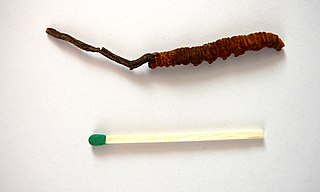
Ophiocordyceps sinensis, known colloquially as caterpillar fungus, is an entomopathogenic fungus in the family Ophiocordycipitaceae. It is mainly found in the meadows above 3,500 metres (11,500 ft) on the Tibetan Plateau in Tibet and the Himalayan regions of Bhutan, India, and Nepal. It parasitizes larvae of ghost moths and produces a fruiting body which is valued in traditional Chinese medicine as an aphrodisiac. Caterpillar fungus contains the compound cordycepin, an adenosine derivative. However, the fruiting bodies harvested in nature usually contain high amounts of arsenic and other heavy metals, so they are potentially toxic and sales have been strictly regulated by China's State Administration for Market Regulation since 2016.
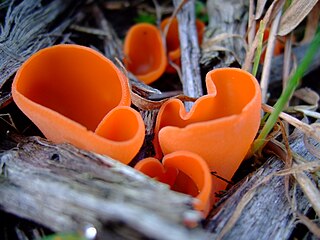
The Pezizales are an order of the subphylum Pezizomycotina within the phylum Ascomycota. The order contains 16 families, 199 genera, and 1683 species. It contains a number of species of economic importance, such as morels, the black and white truffles, and the desert truffles. The Pezizales can be saprobic, mycorrhizal, or parasitic on plants. Species grow on soil, wood, leaves and dung. Soil-inhabiting species often fruit in habitats with a high pH and low content of organic matter, including disturbed ground. Most species occur in temperate regions or at high elevation. Several members of the Sarcoscyphaceae and Sarcosomataceae are common in tropical regions.

Podosphaera pannosa is a plant pathogen. It produces a powdery mildew on members of the rose family.
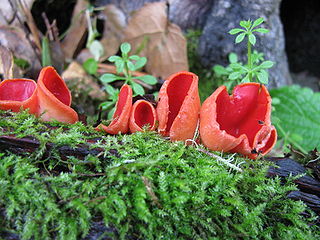
Sarcoscypha coccinea, commonly known as the scarlet elf cup, or the scarlet cup, is a species of fungus in the family Sarcoscyphaceae of the order Pezizales. The fungus, widely distributed in the Northern Hemisphere, has been found in Africa, Asia, Europe, North and South America, and Australia. The type species of the genus Sarcoscypha, S. coccinea has been known by many names since its first appearance in the scientific literature in 1772. Phylogenetic analysis shows the species to be most closely related to other Sarcoscypha species that contain numerous small oil droplets in their spores, such as the North Atlantic island species S. macaronesica. Due to similar physical appearances and sometimes overlapping distributions, S. coccinea has often been confused with S. occidentalis, S. austriaca, and S. dudleyi.

The Pyronemataceae are a family of fungi in the order Pezizales. It is the largest family of the Pezizales, encompassing 75 genera and approximately 500 species. Phylogenetic analyses does not support the prior classifications of this family, and suggest that the family is not monophyletic as it is currently circumscribed.

Geopyxis is a genus of fungi in the family Pyronemataceae. The genus has a widespread distribution. Molecular phylogenetic studies published in 2007 suggest that the genus is not monophyletic.
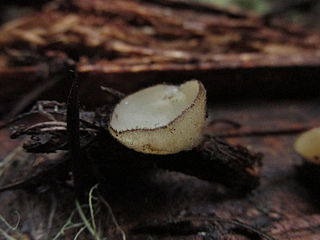
Chaetothiersia is a fungal genus in the family Pyronemataceae. It is monotypic, containing the single species C. vernalis collected from California.
Lazuardia is a monotypic genus of cup fungi in the family Pyronemataceae. The type species, Lazuardia lobata, grows on the ground in Ceylon, India, Java, Sumatra, Cuba, Jamaica and Trinidad. Ascospores are spherical and have dimensions of 8.4–11.4 µm.

Humaria hemisphaerica is a species of fungus in the family Pyronemataceae. In the UK it has the recommended English name of glazed cup; in North America it has been called the hairy fairy cup or the brown-haired fairy cup. Ascocarps are cup-shaped and can be recognized by their smooth, white inner surface and hairy, brown outer surface. The species is ectomycorrhizal and occurs in Europe and North America.
Trichophaeopsis is a genus of fungi in the family Pyronemataceae.

Paurocotylis is a genus of fungi in the family Pyronemataceae. The genus contains multiple species, with the most well known being Paurocotylis pila, a truffle-like fungus found in Europe and New Zealand. It was described by Miles Joseph Berkeley in 1855. Species found in countries other than New Zealand include P. watlingii, P. singeri, P. prima, P. patagonica, P. niveus, P. echinosperma and P. bynumii.

Geopyxis carbonaria is a species of fungus in the genus Geopyxis, family Pyronemataceae. First described to science in 1805, and given its current name in 1889, the species is commonly known as the charcoal loving elf-cup, dwarf acorn cup, stalked bonfire cup, or pixie cup. The small, goblet-shaped fruitbodies of the fungus are reddish-brown with a whitish fringe and measure up to 2 centimetres across. They have a short, tapered stalk.

Scutellinia scutellata, commonly known as the eyelash pixie cup, eyelash cup, the Molly eye-winker, the scarlet elf cap, the eyelash fungus or the eyelash pixie cup, is a small saprophytic fungus in the family Pyronemataceae. It is the type species of Scutellinia, as well as being the most common and widespread. The fruiting bodies are small red cups with distinctive long, dark hairs or "eyelashes". These eyelashes are the most distinctive feature and are easily visible with a magnifying glass.

Chorioactis is a genus of fungi that contains the single species Chorioactis geaster. The mushroom is commonly known as the devil's cigar or the Texas star in the United States, while in Japan it is called kirinomitake (キリノミタケ). This extremely rare mushroom is notable for its unusual appearance and disjunct distribution; it is found only in select locales in Texas and Japan. The fruit body, which grows on the stumps or dead roots of cedar elms or dead oaks, somewhat resembles a dark brown or black cigar before it splits open radially into a starlike arrangement of four to seven leathery rays. The interior surface of the fruit body bears the spore-bearing tissue known as the hymenium, and is colored white to brown, depending on its age. The fruit body opening can be accompanied by a distinct hissing sound and the release of a smoky cloud of spores.
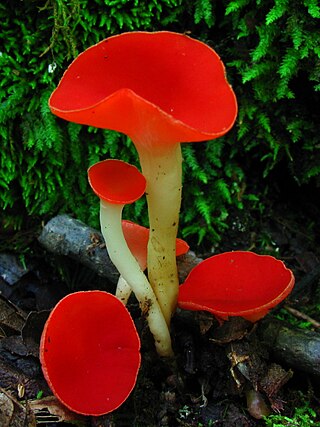
Sarcoscypha occidentalis, commonly known as the stalked scarlet cup or the western scarlet cup, is a species of fungus in the family Sarcoscyphaceae of the Pezizales order. Phylogenetic analysis has shown that it is most closely related to other Sarcoscypha species that contain large oil droplets in their spores. S. occidentalis has an imperfect form, classified as Molliardiomyces occidentalis.

Otidea is a genus of fungi in the family Pyronemataceae. The genus is widely distributed in northern temperate regions.

Otidea bufonia is a species of apothecial fungus belonging to the family Pyronemataceae. The fruit body appears from late summer to early autumn as a dark brown, deep cup, split down one side, up to 6 cm high and the same across.

Chlorovibrissea is a genus of six or more aquatic or semi-aquatic fungi in the family Vibrisseaceae. Most species are found in Australasia but C. chilensis, described as new to science in 2014, is from South America and C. korfii is from China.
Wenying Zhuang is a Chinese mycologist. She is known for her contributions to the study of species diversity and phylogeny of Ascomycetes.

Geopyxis vulcanalis, commonly known as the vulcan pixie cup, is a species of cup fungus in the family Pyronemataceae. It was first described scientifically in 1878 by American mycologist Charles Horton Peck, from collections made in the Adirondack Mountains in Upstate New York. Pier Andrea Saccardo transferred it to the genus Geopyxis in 1889.
















